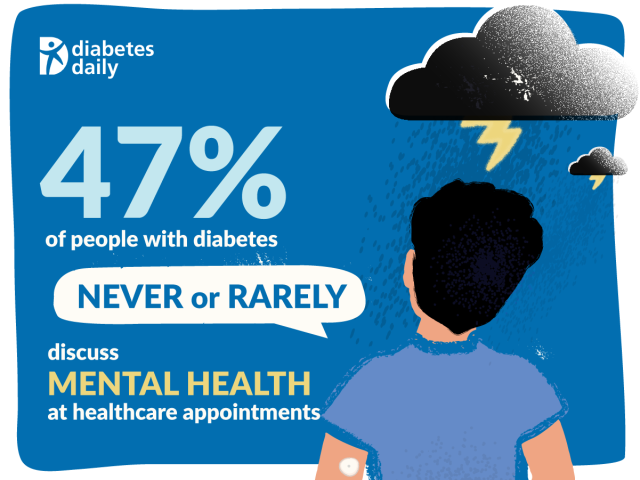Wellness
New Survey Measures Shortfalls and Gaps in American Diabetes Treatment
Are people with diabetes satisfied with the care that they’re receiving today? Our new survey found out.

Are people with diabetes getting the medical attention that they deserve? Are they satisfied with the quality of care they receive?
We wanted to know. This fall, we convened a panel of over 500 people with diabetes to learn how they felt about their experiences at healthcare appointments. Our survey examined interactions with healthcare providers and access to medical resources. It also aimed to identify any disparities based on ethnicity or socioeconomic status.
The results revealed that a surprising number of people with diabetes rarely or never discuss their mental health, diet and exercise habits, or even lab results with their healthcare providers. The results also showed that socioeconomic, racial, and ethnic disparities do exist.
We spent the month of November reporting on what we learned from our survey, resulting in three deep dives that were organized around the survey’s most thought-provoking results:
- 1 percent of people with diabetes rarely or never discuss mental health at healthcare appointments.
- Black and Latino people with diabetes are about half as likely to feel supported or empowered at healthcare appointments as white patients.
- 7 percent of people with diabetes rarely or never discuss diet or exercise with their healthcare providers.
This article will take all of the most important insights from our work and combine them in one overview.
The Panel
Our survey was created in collaboration with our friends at Thrivable, a real-time market research platform. Thrivable amplifies the voices of people with chronic conditions by designing surveys, interviews, focus groups, and usability studies, connecting patients and companies to create better products and services for the next generation of healthcare.
Our results were based on a national online survey conducted between Sept. 6 and 19, 2022, of 532 people living with type 1 and type 2 diabetes. Our survey panelists were selected by Thrivable to create a nationally representative sample. The participants hailed from all parts of the United States, were of all different ages, and were ethnically and socioeconomically diverse. About 60 percent of the panel had type 2 diabetes, and most of the rest had type 1. Our participants held many different types of insurance coverage, including Medicare, Medicaid, private insurance, marketplace insurance, and employee insurance. Some had no insurance at all.
Diabetes and Mental Health
We have heard many in the diabetes community — patients and clinicians alike — complain that patients just do not get the type of mental health attention that they deserve. We wanted to know how people with diabetes felt about the care they were receiving.
Mental health issues are astonishingly common in people with diabetes — both type 1 diabetes and type 2. These chronic conditions, which entail such immense cognitive and emotional burdens, frequently lead to anxiety, stress, depression, and diabetes distress. Poor mental health has major consequences for physical health, too. Such issues are associated with higher glucose levels and an increased likelihood of diabetic complications and early death.

Santiago Paulós/ @thediabeticsurvivor
Here’s what we found:
- 47 percent of all respondents reported only rarely or never discussing mental health at their diabetes healthcare appointments — a finding that did not vary significantly between types 1 and 2.
We found this result distressing, given how intertwined mental well-being is with optimal diabetes management. Are patients getting the help they need?
Experts are beginning to recognize how integral flourishing mental health is to good diabetes management. A 2020 review, for example, argued that endocrinology clinics should integrate behavioral health services into their standard care offering in order to optimize patient health and improve quality of life. But change, if it comes, will be slow.
- Certified diabetes educators (CDCESs) and diabetes coaches were more likely (a combined 54.8 percent) to address the topic than doctors, endocrinologists, and nurse practitioners (38.5 percent).
In fact, diabetes coaches —uncredentialed advisors that cannot replace a doctor — were the most likely to frequently address mental health, possibly an indication of the way in which our medical system tends to pass off these psychological issues as a secondary concern.
The treatment of diabetes-related mental health issues is very often a fragmented affair. Patients might end up seeing one doctor for their metabolism, and another for their brain, and the two specialists never collaborate, despite how intertwined the two conditions really are.
Our numbers did hint that patients most in need of mental health help are more likely to get it from their diabetes healthcare providers:
- 41 percent and 25.7 percent of Black and Latino survey respondents, respectively, rarely or never discussed mental health, compared with 53.6 percent of white participants.
- 55 percent of those that reported earning over $100,000 per year discussed mental health only rarely or never, compared with 29.7 percent of those in the lowest income bracket.
It’s possible that these results are just another indication of systemic inequities and health outcome disparities. Perhaps white and wealthy diabetes patients are less likely to discuss their mental health status with their diabetes care providers because they’re better able to access professional psychological help. Or perhaps they are less likely to experience diabetes distress in the first place, as some studies have suggested.
Emotions at Healthcare Appointments
And then there’s the experience of the healthcare appointment itself. It’s tough to get the most out of the opportunity to refine your care if you feel dismissed or ill-treated during the visit.
A majority of our panelists reported having “somewhat” or “very” positive experiences, but the results were by no means universal. We learned that patients with type 1, men, whites, and the wealthy were all more likely to be satisfied with the emotional support they received than patients with type 2, women, Black people and Latinos, and those with lower incomes.
Some of these disparities, clearly, cannot simply be fixed by targeted improvements in bedside manner. Nevertheless, the results do suggest how our diabetes care providers might prioritize changes in their approach, so as to empower those who need it most.
Healthcare Access Disparities
Race, ethnicity, wealth — these factors play far too large a role in American healthcare. It’s a sad situation that has a big effect within the diabetes community.
Much has been written on the complex causes and consequences of these systemic inequities, but we wanted to learn how people with diabetes really feel about the care they receive today, right now, in the year 2022.
Unfortunately, but unsurprisingly, our survey confirmed that there are sharp racial and socioeconomic lines dividing the diabetes community.
The Results: Race/Ethnicity and Access to Diabetes Expertise
Perhaps the most fundamental manifestation of America’s racial and ethnic healthcare problem is unequal access to healthcare resources.
White respondents to our survey were more than twice as likely (55 percent) to see an endocrinologist as Black (22 percent) and Latino (17 percent) respondents. When we broke down the data by diagnosis — to ensure that differing rates of type 1 and 2 diabetes didn’t account for the gap — we found the same association. For example, 34 percent of White Americans with type 2 diabetes see an endocrinologist, compared with only 16 percent of Black people and 14 percent of Latinos.
It’s an eye-opening finding. White Americans, clearly, are far more likely to be treated by a specialist.
Black and Latino respondents were also significantly less likely to rate their provider as “extremely knowledgeable,” or to discuss new treatments and technology at their healthcare visits.
One of our simplest survey questions turned out to be one of the most illuminating. We learned that white patients have a much easier time booking medical appointments, with 73 percent reporting that it was “very easy” to schedule appointments. Only 53 percent of Black respondents and 43 percent of Latinos gave the same answer. Could there be a more concise illustration of healthcare access disparities?

Race/Ethnicity and Emotional Support
Black and Latino respondents also appear to be far less satisfied and comforted by the medical care they are receiving.
The problems start before the appointment even begins, as Black and Latino participants reported much higher levels of anxiety before seeing their healthcare providers.
The converse is also true. White survey participants were about three times as likely to report feeling “very calm” before and during appointments.
An uncomfortable medical appointment might be more impactful than it initially appears. Anxiety can be a big part of life with diabetes, both a cause of diabetes progression and a symptom of the condition. It’s a vicious cycle.
Things don’t get much better during and after the appointment. White respondents were significantly more likely to say they feel very supported, very empowered, and very validated than Black and Latino respondents.
Inequality — or, at the very least, the perception of inequality — impacts members of the diabetes community immediately before, during, and after healthcare appointments.
Income and Access
Race and ethnicity aren’t everything — America’s healthcare inequality problem also shows up in a big way when we compare the haves and the have-nots.
Our survey provides a clear picture: As patients become wealthier, they are increasingly able to access a team of experts to optimize their diabetes care. Less affluent patients seem more likely, on the other hand, to make do with a single professional.
- Nearly 50 percent of respondents that reported an income under $15,000 see a general practitioner for their diabetes. Our more affluent participants were far less likely to see a generalist.
- CDCESs, diabetes coaches, and registered dieticians appear to be luxury items. Almost nobody earning less than $50,000 saw one of these professionals.
It’s tough to thrive with diabetes if you don’t have access to the best medical technologies and therapies. We know that access in America, compared with some other parts of the world, is profoundly unequal.
Our survey confirmed the income gap. To take one example, there was a positive correlation between income and continuous glucose monitor (CGM) usage. Only 28.9 percent of those earning less than $15,000 used a CGM, compared with 100 percent of those in the highest income bracket.
In order to extricate the effect of race or ethnicity, we also looked at the numbers for white Americans alone. They told much the same story. White respondents earning less money were less likely to discuss new technology and new treatments with their healthcare providers.
Doctors and endocrinologists cannot reverse America’s inequality problems by themselves. But they can pledge to recommend the best treatments to their patients without prejudice and to advocate on their behalf to insurers.
Covering Diet and Exercise
There’s no doubt that diet is absolutely fundamental to diabetes care. “Comprehensive” dietary change is part of the first line of treatment for people with type 2 diabetes, and people with type 1 diabetes quickly learn that their condition requires careful consideration of practically every mouthful that they take for the rest of their lives. For many of us, life with diabetes is largely defined by what it means for our eating habits.

Imagine our surprise when 22.7 percent of our panelists reported they rarely (17.0 percent) or never (5.7 percent) discuss nutrition, diet, or ways of eating at their healthcare appointments.
Exercise is, like diet, part and parcel of the comprehensive lifestyle modifications that are recommended as the first line of treatment for people with type 2 diabetes. And yet, a substantial minority of panel members (21 percent) told us that they rarely or never discuss exercise at healthcare appointments.
Undoubtedly, a major cause of these shortfalls is the fact that the doctors and nurses of the United States simply do not have enough time. There are wide reports of shortages among family doctors, registered nurses, and endocrinologists. Many of these professionals wish that they could spend more time with each patient but are prevented from doing so by a healthcare system over which they have no control.
The pattern of responses further suggests that patients with greater means are better able to access care that addresses the totality of their conditions.
Our survey suggested that endocrinologists are more likely to discuss diet and nutrition than generalists like family doctors and nurse practitioners. It may simply be that endocrinologists have more time. Primary care providers, after all, must care for all of a patient’s healthcare needs.
Meanwhile, diabetes coaches and CDCESs are even more likely than endos to discuss these important lifestyle-based therapies. But, as we saw above, almost nobody earning less than $50,000 saw one of these professionals. The result is a topsy-turvy situation in which patients with less money likely receive less instruction on diet and exercise, the least expensive diabetes therapies out there.
Conclusions
Diabetes touches nearly every aspect of life. It’s been said that type 1 diabetes impacts well over a hundred decisions per day, and type 2 diabetes can be just as all-consuming, especially for those that use insulin. How can doctors, endocrinologists, and nurse practitioners hope to help their patients refine not just their medication use but also their diets, their exercise, their sleep habits, their mental health? And how can they hope to devote just as much attention to those from disadvantaged communities?
Unfortunately, our survey confirms that they often can’t. Many people with diabetes receive suboptimal care, for many reasons. Healthcare providers are badly overworked, and the American medical system does not offer anything like equal access to the best care and resources.
We hope that our survey taking the measure of these care shortfalls and gaps in the year 2022 will help clinicians, authorities, and patients alike to understand what we need to improve to make sure every person with diabetes gets the attention and resources that they need to thrive.

Lion’s Mane Mushroom: History, Benefits, and Adaptogen Properties
Explore the intriguing world of Lion’s Mane Mushroom in our comprehensive guide. Dive into its unique properties, historical significance, and myriad health…
AI can already diagnose depression better than a doctor and tell you which treatment is best
Artificial intelligence (AI) shows great promise in revolutionizing the diagnosis and treatment of depression, offering more accurate diagnoses and predicting…
Reasons You should Get this: Neptune Wellness Solutions Inc (NASDAQ:NEPT), WeTrade Group Inc. (NASDAQ:WETG)
NEPT has seen its SMA50 which is now -9.28%. In looking the SMA 200 we see that the stock has seen a -92.25%. WETG has seen its SMA50 which is …
The…













